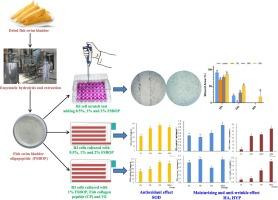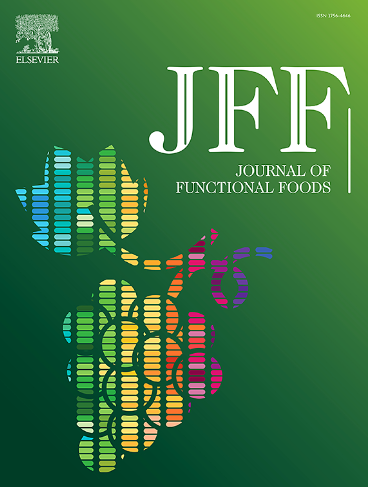评估膀胱提取的寡肽对皮肤营养和健康的体外影响
IF 3.8
2区 农林科学
Q2 FOOD SCIENCE & TECHNOLOGY
引用次数: 0
摘要
利用人体成纤维细胞(BJ 细胞)在体外研究鱼鳔寡肽(FSBOP)的护肤效果。伤口愈合结果显示,经 0.5 % FSBOP 处理的细胞的细胞迁移能力明显增强(P < 0.05)。经 0.5 %、1 % 和 2 % FSBOP 处理的细胞的 SOD 和 GSH-Px 活性明显提高(P < 0.05)。此外,1 % 的维生素 E(VE)和鱼胶原蛋白肽(CP)能明显提高 SOD 和 GSH-Px 活性。经 FSBOP、CP 和 VE 处理后,羟脯氨酸(HYP)含量增加(P < 0.05)。1 % FSBOP 组和 2 % FSBOP 组细胞中的透明质酸(HA)含量更高(P < 0.05)。1 % VE 组和 FSBOP 组的 HA 含量明显更高(P < 0.05)。结论是,寡肽具有良好的抗氧化、保湿和抗皱效果,并能促进伤口修复,因此可能在化妆品行业中发挥作用。本文章由计算机程序翻译,如有差异,请以英文原文为准。

Evaluation of swim bladder-derived oligopeptides on skin nutrition and health in vitro
Human fibroblast cells (BJ cells) were used in vitro to study the skin-care effects of fish swim bladder oligopeptides (FSBOP). Wound healing results showed that cell migration was significantly enhanced in cells treated with 0.5 % FSBOP (P < 0.05). SOD and GSH-Px activities in cells treated with 0.5 %, 1 % and 2 % FSBOP were significantly increased (P < 0.05). In addition, 1 % vitamin E (VE) and fish collagen peptide (CP) significantly induced SOD and GSH-Px activitiy. The hydroxyproline (HYP) content increased after treatment with FSBOP, CP, and VE (P < 0.05). The cells showed greater amounts of hyaluronic acid (HA) in the 1 % and 2 % FSBOP groups (P < 0.05). The HA content in the 1 % VE and FSBOP groups was significantly higher (P < 0.05). It was concluded that oligopeptides might be useful in the cosmetics industry as oligopeptides have good antioxidant, moisturizing, and anti-wrinkle effects, and promote wound repair.
求助全文
通过发布文献求助,成功后即可免费获取论文全文。
去求助
来源期刊

Journal of Functional Foods
FOOD SCIENCE & TECHNOLOGY-
CiteScore
9.60
自引率
1.80%
发文量
428
审稿时长
76 days
期刊介绍:
Journal of Functional Foods continues with the same aims and scope, editorial team, submission system and rigorous peer review. We give authors the possibility to publish their top-quality papers in a well-established leading journal in the food and nutrition fields. The Journal will keep its rigorous criteria to screen high impact research addressing relevant scientific topics and performed by sound methodologies.
The Journal of Functional Foods aims to bring together the results of fundamental and applied research into healthy foods and biologically active food ingredients.
The Journal is centered in the specific area at the boundaries among food technology, nutrition and health welcoming papers having a good interdisciplinary approach. The Journal will cover the fields of plant bioactives; dietary fibre, probiotics; functional lipids; bioactive peptides; vitamins, minerals and botanicals and other dietary supplements. Nutritional and technological aspects related to the development of functional foods and beverages are of core interest to the journal. Experimental works dealing with food digestion, bioavailability of food bioactives and on the mechanisms by which foods and their components are able to modulate physiological parameters connected with disease prevention are of particular interest as well as those dealing with personalized nutrition and nutritional needs in pathological subjects.
 求助内容:
求助内容: 应助结果提醒方式:
应助结果提醒方式:


